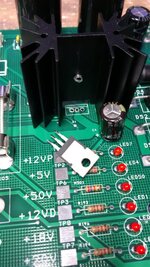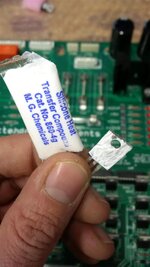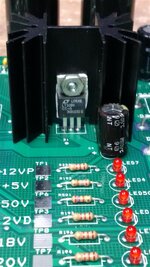So I had a well known PB Rev member that started having issues with a couple of his Rottendog WPC driver boards. He had decided to install a pair of them in his TAF and WH20 for some "peace of mind", and they certainly did the trick. That was until he opted to install some ColorDMD's in each of these games.
While hosting a small get together, both of the games developed reset issues. Seeing as his game room was specifically designed as such, incoming power was not the issue and a quick DMM measurement confirmed that. What we did notice was the ambient temp in the game room at the time was VERY warm and the games didn't seem to develop the reset issue until after being on / played for a while. To rule out all other aspects of the game as the culprit we re-installed a known good original WPC driver board, and low and behold the reset issues stopped! Hmmm....
With the RD boards removed from the game I gave them a quick visual just in case there were any cold / cracked solder joints, or anything else that might stand out. Nothing immediately obvious at first, so I took the rest of my time at the party to brainstorm a little. Now usually these types of reset issues revolve around the 5V line, and based on the original design spec most WPC games do not have a lot of headroom and any little hiccup can trip the watchddog circuit. So I began to suspect the ColorDMD was taxing the 5V line on these RD drivers too much, but how? I mean this thing is built to the original driver spec's so how can the original handle the load but the RD board have trouble? And where both games with RD boards installed both had the exact same issues it was way too much of a coincidence to ignore. Here was my suspicion...
The original driver generates the 5V @ 3A using a TO-3 device (LM323K) mated to a nice big heatsink. The RD board does this differently because TO-3 style devices are an "old school" technology and are rarely being made anymore, so they opted to use the more standard TO-220 package with the same ratings of 5V @ 3A mated to a heatsink. Where the game didn't start having issues until the ambient temps in the room were high, I suspected that the 5V regulator was hitting it's thermal limit which affects it's ability to sustain a stable output... but why? I grabbed one of the RD boards again and upon closer inspection it appeared the 5V regulator didn't have any thermal paste between the part and the heatsink, which is VERY important, but I wouldn't be able to tell for sure without physically separating the part from the heatsink. Unfortunately for me, RD chose to rivet the regulator to the heatsink instead of using a screw & nut combo... so the only way to make that happen would be to drill it out. The only other thing I was contemplating was the size of the heatsink used for that regulator could be a bit on the small side, but that's just my initial observation and personal opinion.
At any rate, these two boards had issues and where they appeared to be having thermal issues with the regulators the damage had already been done, and the likelyhood of these boards remaining stable going forward was suspect. So I took the boards with me, with a plan to replace these regulators... but I wasn't only thinking of replacing the regulators I was also thinking I would upgrade them at the same time!
Once on the bench, I desoldered the regulator and drilled out the rivet. Low and behold...

Not a spec of thermal paste to be found! The reason thermal paste is so important in this type of application is air is not good at conducting heat. Even if the part is riveted or screwed to the heatsink, without thermal paste between the two you have air pockets and the heatsink is unable to dissipate the heat from the part efficiently. So it looks like I'm on the right track with my initial belief, and the regulators will need to be replaced.
After doing a little homework, I confirmed that I could get 5V regulators in the same package with higher current ratings so I opted to pickup a couple 5V @ 5A versions. I felt the existing design could handle the slightly higher current rating without changing the heatsink. (there was one higher current rated part but I felt it would also require replacing the heatsink and where it's soldered directly to the pcb ground plane that's not something I wanted to get into) The part I selected was from the same series that was originally used by RD, and after studying the datasheet I also found the capacitor that was originally used in conjunction with the regulator to help stabilize the output was underspec'd. It wasn't by much but the original was 100uF and the datasheet optimum calls for 150uF+, so I figured when in rome...
Here is the all important thermal paste applied to the new part. Notice how I didn't use a lot? A little goes a long way here...

And the repair completed, with the new regulator and 220uF cap installed...

I am not sure if the owner has bothered to re-install the RD boards back into his TAF & Wh20 yet, but I am hoping to get some sort of feedback at some point and I will update this thread with the results. If anyone using a RD driver board in their WPC machine is having reset issues and you've ruled out all the other potential causes, definitely give your regulator a once over and check for thermal paste or sil-pad.
D
While hosting a small get together, both of the games developed reset issues. Seeing as his game room was specifically designed as such, incoming power was not the issue and a quick DMM measurement confirmed that. What we did notice was the ambient temp in the game room at the time was VERY warm and the games didn't seem to develop the reset issue until after being on / played for a while. To rule out all other aspects of the game as the culprit we re-installed a known good original WPC driver board, and low and behold the reset issues stopped! Hmmm....
With the RD boards removed from the game I gave them a quick visual just in case there were any cold / cracked solder joints, or anything else that might stand out. Nothing immediately obvious at first, so I took the rest of my time at the party to brainstorm a little. Now usually these types of reset issues revolve around the 5V line, and based on the original design spec most WPC games do not have a lot of headroom and any little hiccup can trip the watchddog circuit. So I began to suspect the ColorDMD was taxing the 5V line on these RD drivers too much, but how? I mean this thing is built to the original driver spec's so how can the original handle the load but the RD board have trouble? And where both games with RD boards installed both had the exact same issues it was way too much of a coincidence to ignore. Here was my suspicion...
The original driver generates the 5V @ 3A using a TO-3 device (LM323K) mated to a nice big heatsink. The RD board does this differently because TO-3 style devices are an "old school" technology and are rarely being made anymore, so they opted to use the more standard TO-220 package with the same ratings of 5V @ 3A mated to a heatsink. Where the game didn't start having issues until the ambient temps in the room were high, I suspected that the 5V regulator was hitting it's thermal limit which affects it's ability to sustain a stable output... but why? I grabbed one of the RD boards again and upon closer inspection it appeared the 5V regulator didn't have any thermal paste between the part and the heatsink, which is VERY important, but I wouldn't be able to tell for sure without physically separating the part from the heatsink. Unfortunately for me, RD chose to rivet the regulator to the heatsink instead of using a screw & nut combo... so the only way to make that happen would be to drill it out. The only other thing I was contemplating was the size of the heatsink used for that regulator could be a bit on the small side, but that's just my initial observation and personal opinion.
At any rate, these two boards had issues and where they appeared to be having thermal issues with the regulators the damage had already been done, and the likelyhood of these boards remaining stable going forward was suspect. So I took the boards with me, with a plan to replace these regulators... but I wasn't only thinking of replacing the regulators I was also thinking I would upgrade them at the same time!
Once on the bench, I desoldered the regulator and drilled out the rivet. Low and behold...

Not a spec of thermal paste to be found! The reason thermal paste is so important in this type of application is air is not good at conducting heat. Even if the part is riveted or screwed to the heatsink, without thermal paste between the two you have air pockets and the heatsink is unable to dissipate the heat from the part efficiently. So it looks like I'm on the right track with my initial belief, and the regulators will need to be replaced.
After doing a little homework, I confirmed that I could get 5V regulators in the same package with higher current ratings so I opted to pickup a couple 5V @ 5A versions. I felt the existing design could handle the slightly higher current rating without changing the heatsink. (there was one higher current rated part but I felt it would also require replacing the heatsink and where it's soldered directly to the pcb ground plane that's not something I wanted to get into) The part I selected was from the same series that was originally used by RD, and after studying the datasheet I also found the capacitor that was originally used in conjunction with the regulator to help stabilize the output was underspec'd. It wasn't by much but the original was 100uF and the datasheet optimum calls for 150uF+, so I figured when in rome...
Here is the all important thermal paste applied to the new part. Notice how I didn't use a lot? A little goes a long way here...

And the repair completed, with the new regulator and 220uF cap installed...

I am not sure if the owner has bothered to re-install the RD boards back into his TAF & Wh20 yet, but I am hoping to get some sort of feedback at some point and I will update this thread with the results. If anyone using a RD driver board in their WPC machine is having reset issues and you've ruled out all the other potential causes, definitely give your regulator a once over and check for thermal paste or sil-pad.
D
Last edited:
